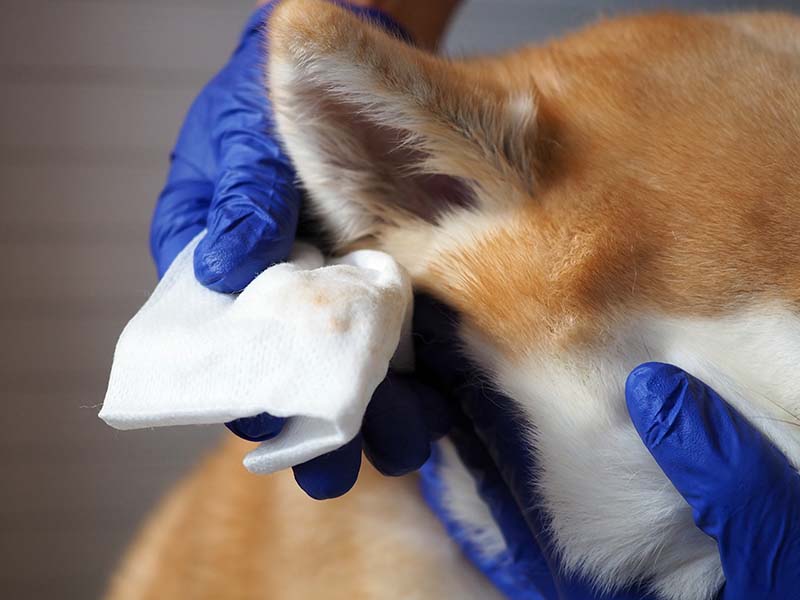No one likes the look of dry, patchy, or flaky skin, and although our dogs probably aren’t too worried about their appearance, dry skin can indicate a range of health issues, with some being mild and some more serious. While many of these issues will cause changes all over the body, there are some that may be restricted to certain areas, like the ears.
In the following article, we’re going to take a look at a range of conditions that might cause dry skin on dogs’ ears and what can be done to help these issues.

What Causes Dry Skin on Dog Ears?
Anything that can affect the skin can affect the ears, which is why dogs that suffer from skin allergies or infections often suffer from ear problems as well. When the skin on the ears becomes dry, it can appear flaky, crusty, red, hairless, and may also be itchy. It may be caused by a problem with the ears themselves, or it could be a sign of something else entirely.
If your dog suffers from dry skin on their ears, below are some of the conditions that could be to blame.

1. Allergies
If your dog is affected by environmental allergens, seasonal allergies or food reactions, they are likely to be itchy in more places than one. You’ll see them chewing their feet, rubbing their face, dragging their bellies, and scratching their ears, which can cause the skin to become damaged and dry.
Allergies can be a real nightmare for you and your dog, as there are often multiple triggers involved, and it often requires a lot of time, patience, and sometimes money to get to the bottom of the problem and work out the best way to manage it. While it is often easy to recognize when a dog is suffering from an allergy, working out what they are allergic to is the difficult part.
2. Otitis Externa
Otitis externa, the infection of the outer portion of the dog’s ear canal and pinna (ear flap), more often results in an ear that is red, itchy, painful, and moist. However, dogs that suffer from repeated infections, especially those that also have allergies, often develop thickened dry skin around the entrance to the ear canal.
Ear infections are relatively easy to diagnose. Your vet will use an otoscope to examine the ear canal and tympanic membrane (ear drum) and will take a sample of any discharge to examine under the microscope and/or send it away to be cultured. Otitis can be caused by multiple bacterial and fungal organisms, sometimes more than one at a time.
Treating otitis usually involves the use of ear drops as well as an anti-inflammatory steroid medication to reduce the swelling and inflammation in the ear canal.
It is important that the correct treatment is used for the specific infection present, and that a check is performed at the end of the course of treatment to ensure it has been completely eradicated. Skipping this step can mean more resistant infections in the future.

3. Ringworm
Not overly common and not actually caused by a worm, ringworm is a type of fungal infection, known as Dermatophytosis, that can be spread through direct contact with animals or contaminated materials. In dogs, ringworm usually causes scaly, hairless patches of skin which can be circular, although the characteristic ring appearance which gave this infection its name is more common in people. It is not usually very itchy and is most common on the face, ears, legs, and paws, but can cause a problem all over the body.
Diagnosis is usually based on fungal culture of hair samples, and around 50% of infections will glow under a UV light. Hair and scale can also be examined under the microscope to aid diagnosis. In many cases, isolated lesions can be successfully treated with an antifungal cream. Dogs with underlying health issues or weakened immune systems may develop numerous lesions that require systemic antifungal medications or shampoos.
Ringworm is zoonotic, which means it can be spread between humans and animals. If your dog has been diagnosed with ringworm, it is important to check yourself for any lesions. Be sure to wash hands, bedding, and clothing thoroughly after being in contact with an infected animal.
4. Demodectic Mange
Demodex are microscopic, parasitic mites that are a normal inhabitant of the skin, but certain conditions, like genetics and illness, can result in a population explosion. Demodicosis isn’t normally itchy, but it causes dry, hairless, scaly skin to appear. In severe cases, such as immunocompromised dogs, this can affect the entire body, but the most common location for these lesions to appear is around the eyes and ears, particularly in pups and juvenile dogs.
Diagnosis is based on clinical signs and examining scrapings of skin under the microscope.
Demodex mites are not contagious and are only passed down from mother to offspring. Infections can usually be treated with prescription mite treatments, although some cases, particularly in older, immunocompromised dogs, can be more difficult to control.

5. Cutaneous Vasculitis
An uncommon condition but an important one, as it is often misdiagnosed, cutaneous vasculitis is an inflammatory condition of the blood vessels of the skin, and the most common location for the telltale lesions of the disease to appear is on the margins of the pinna (ear flap). Lesions start off as dry, crusting areas on the edges or tips of the pinna, which become dark and start to bleed as the affected skin becomes necrotic. The irritation from these lesions often causes the dog to scratch or shake their head, resulting in further damage and bleeding.
Cutaneous vasculitis can be a sign of tick-borne disease, an atypical reaction to medication or vaccination, or an autoimmune condition. Diagnosis may be based on clinical examination alone, but a tissue biopsy is needed to confirm it.
Treatment involves addressing any underlying causes and using immunosuppressive medication or peripheral vasodilators to improve blood flow to the areas being affected by vasculitis. Treatment is usually successful but requires months of medication, and dogs that have an autoimmune component often need to stay on lifelong immunosuppressive drugs.

How Do I Care for a Dog With Dry Skin on Their Ears?
The first thing to do is to speak to your vet.
If your dog’s ears have become dry, scaly, crusty, or itchy, there is a reason for it, and it is important to get the right diagnosis in order to address the problem.
If your dog suffers from chronically dry skin and ears, it might be time to increase their intake of certain fatty acids. Research has shown that dogs on diets rich in omega-3 fatty acids have improved brain function, joint health, and skin condition, and many commercial dog food diets do not contain enough of this important nutrient. Cold-water fish like salmon, tuna, and mackerel are particularly rich in omega-3 fatty acids, and there are lots of supplements available to add to your dog’s food.


Frequently Asked Questions
Will Cleaning My Dog’s Ears Help?
Not really. Too much cleaning can have the opposite effect, drying out the skin or even opening it up to infection. Only use an ear cleaner as recommended by your veterinarian and avoid using any shampoos around the ears.
Can I Use Moisturizer on My Dog’s Dry Ears?
No. Human moisturizers are specifically designed for the pH and microflora of human skin and can be drying or irritating for our dogs. Additionally, if there is any sort of infection present, adding moisture can actually make the problem worse.

Is There Anything I Can Put on My Dog’s Dry Skin?
There are some pet-safe moisturizing balms and oils on the market that can be helpful for managing dry areas on paws, elbows, and noses. While these products are likely quite safe to apply to dry skin on the ears, they are unlikely to address the underlying issue. But if your dog just has a small patch of dry, non-irritated skin, one of these products might do the trick, but a trip to the vet will be needed if things don’t improve, especially if they get worse.

Final Thoughts
A touch of dry skin on dog ears might be nothing to worry about, and adding some omega-3 into their diet might be the only solution you need. However, there are several conditions that can turn your pup’s ears from velvet to Velcro that will need more than just a supplement to overcome. Take note of any changes in season, diet, habits, or environment, as these can have a huge influence on the health of your dog’s coat and ears and make reaching a diagnosis a little bit easier.
Featured Image Credit: SeventyFour, Shutterstock






















